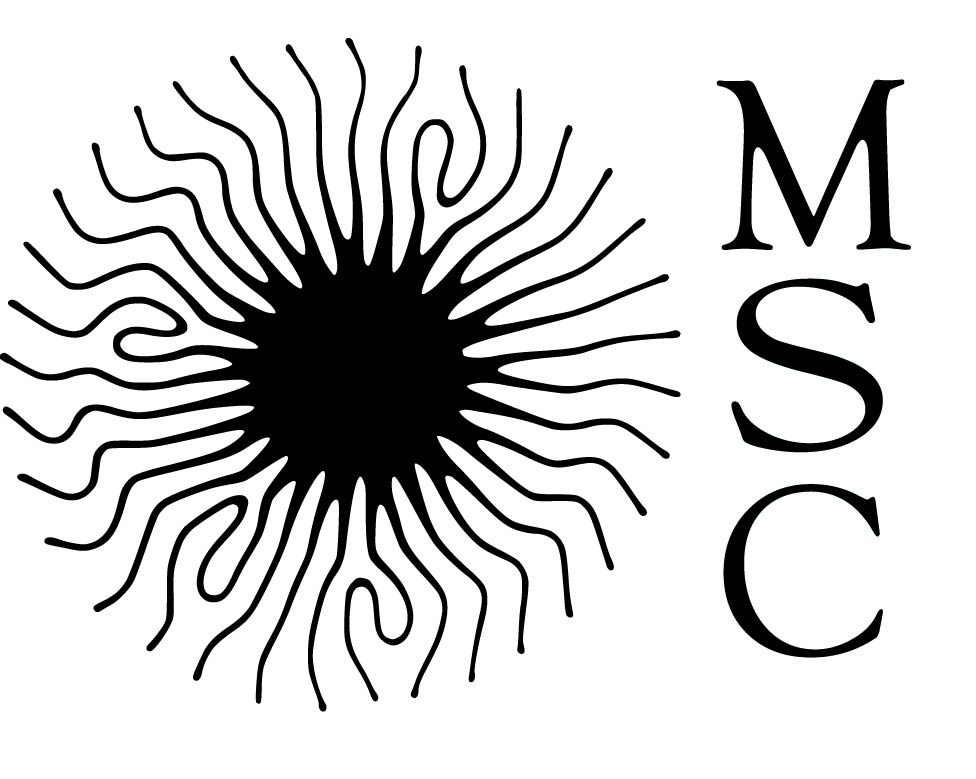Waves, vibrations, instabilities and turbulence
DSHE
This area covers the study of solid or fluid physical systems characterized by their dynamic behavior, often involving non-linear physics. Some situations can be described with a small number of degrees of freedom, while others require a statistical approach. Of particular interest are mechanical vibrations and wave propagation, as well as turbulence, whether hydrodynamic or resulting from the weakly non-linear interaction between waves.
Meandering instabilities
A liquid net injected between two closely spaced parallel plates spontaneously adopts a sinuous trajectory above a threshold flow rate, when inertial forces dominate capillary forces. We have recently discovered a new instability of the net at any flow rate, when forced acoustically using loudspeakers placed on the sides of the cell (see figure). This instability results from a non-linear coupling between a modulation of the cross-section (varicose) and a modulation of the trajectory (sinuous) under the effect of lateral forcing. The wavelength of the perturbations amplified by this coupling – the forcing itself is homogeneous – is determined by the liquid flow velocity, the sinuous wave velocity and the forcing frequency, so as to phase-lock the sinuous and varicose waves.
Participants :
Adrian Daerr.
Thesis of Grégoire Le Lay
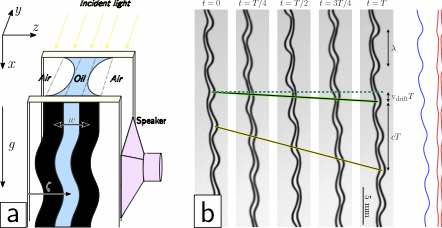
Caption: (a) Experimental setup: the oil wetting the walls of the Hele-Shaw cell forms a liquid bridge over the height of the cell. (b) The instability observed under acoustic forcing couples a varicose mode and a sinuous mode (plotted separately in red and blue, on the right) drifting at different speeds.
Acoustofluidics
The study of fluid motion induced by mechanical or acoustic vibrations is called acoustofluidics. We apply vibrations with large forcing amplitudes either to vibrated solids in confined or extended geometries, or in micro-fluidic channels with angular structures, as well as to droplets. We study the coupling between forcing and complex edge conditions such as free surface or confined geometry. These edge conditions influence the flow produced and the deformations of the free surface.
On the other hand, acoustofluidics research could be used for surface de-icing, where water droplets condense and freeze on a cold surface. De-icing is a problem of industrial interest, particularly in aeronautics.
Participants :
Philippe Brunet, Adrien Bussonnière (MSC, DOMM)

Non-linear waves in a fluid torus
Thanks to an original technique, we have succeeded in experimentally creating a stable liquid torus and obtaining the first measurements of its resonant frequencies, as well as the complete dispersion relation for azimuthal waves along a torus. Concerning non-linear waves
in this toroidal geometry, we have reported the observation of new solitons, due to the periodicity of the system, with significant differences compared to the classical rectilinear Korteweg-de Vries geometry.
Participants :
Eric Falcon, Chi-Tuong Pham.
Thesis of Filip Novkoski
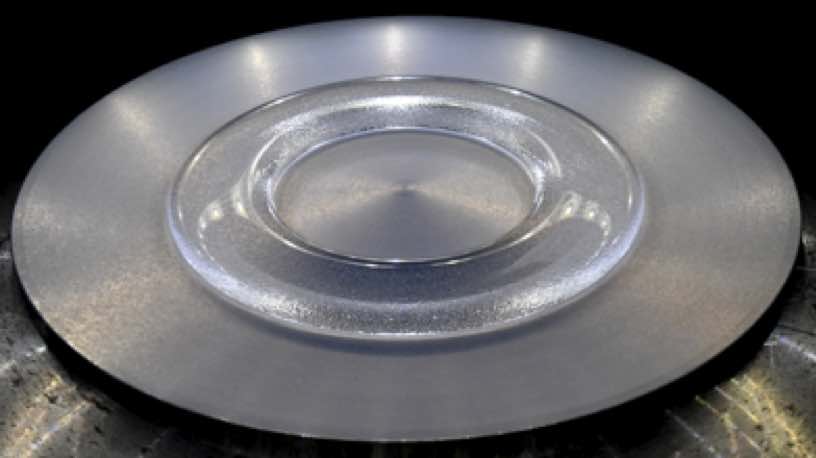
Author Filip Novkoski
Caption: This image of a liquid torus was one of the winners of the CNRS 2022 Méca-Pixel competition and ranked 1st in the LabEx SEAM 2022 Proof par l’Image competition.
Surface wave turbulence
Participants :
Eric Falcon
Theses of Guillaume Ricard and Annette Cazaubiel
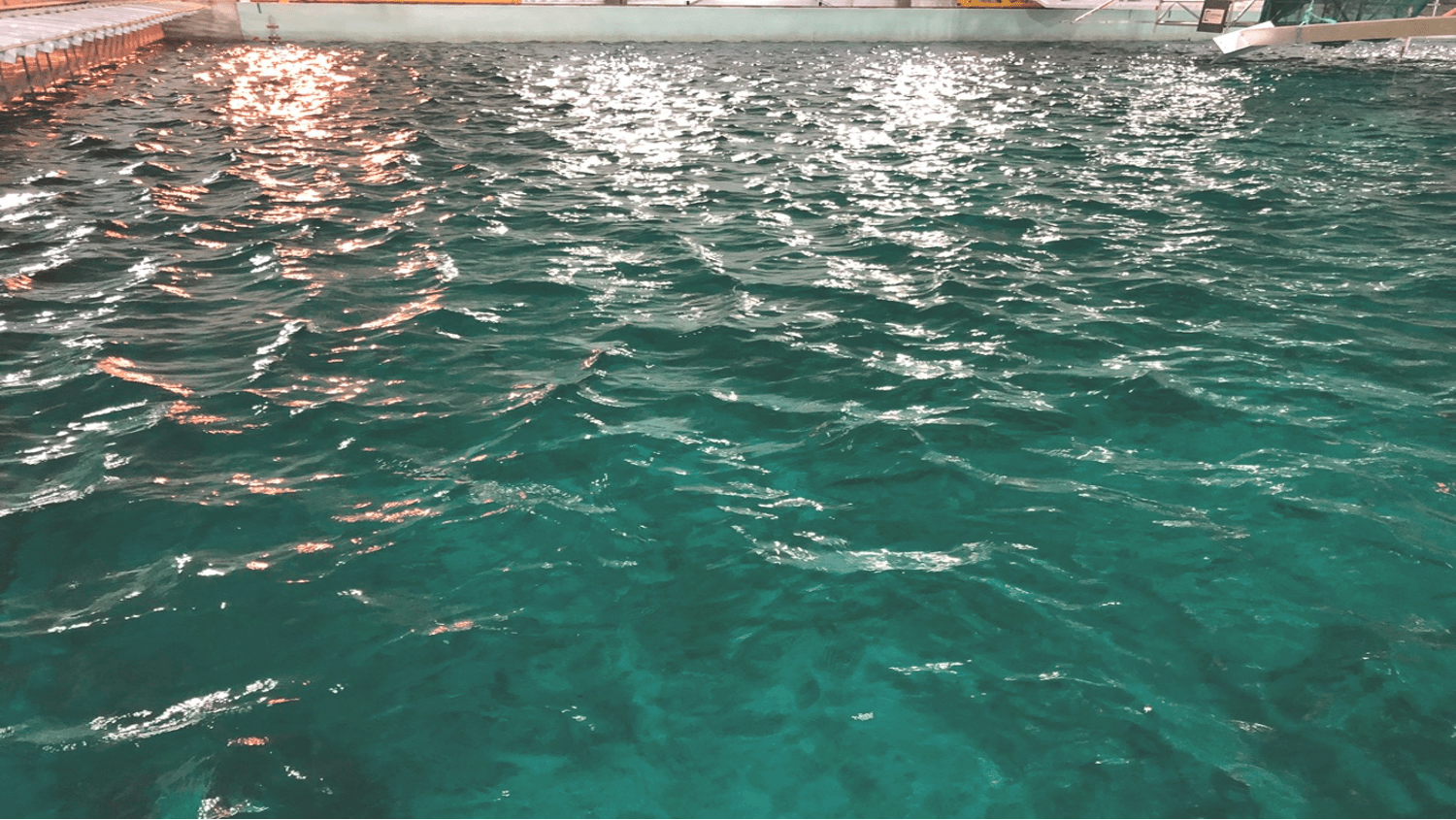
Caption: A set of random waves interacting non-linearly on the surface of a 50 m x 30 m x 5 m pool at Ecole Centrale de Nantes. Credit: E. Falcon.
Capillary wave turbulence in weightlessness
To get closer to the theoretical framework of wave turbulence, capillary-wave turbulence experiments in weightlessness were carried out on the International Space Station (ISS) as part of the Fluidics experiment (LPENS collaboration, CNES, ESA). In this case, the effect of gravity is suppressed and surface tension forces are the only restoring mechanism.
Participants :
Michael Berhanu, Eric Falcon,
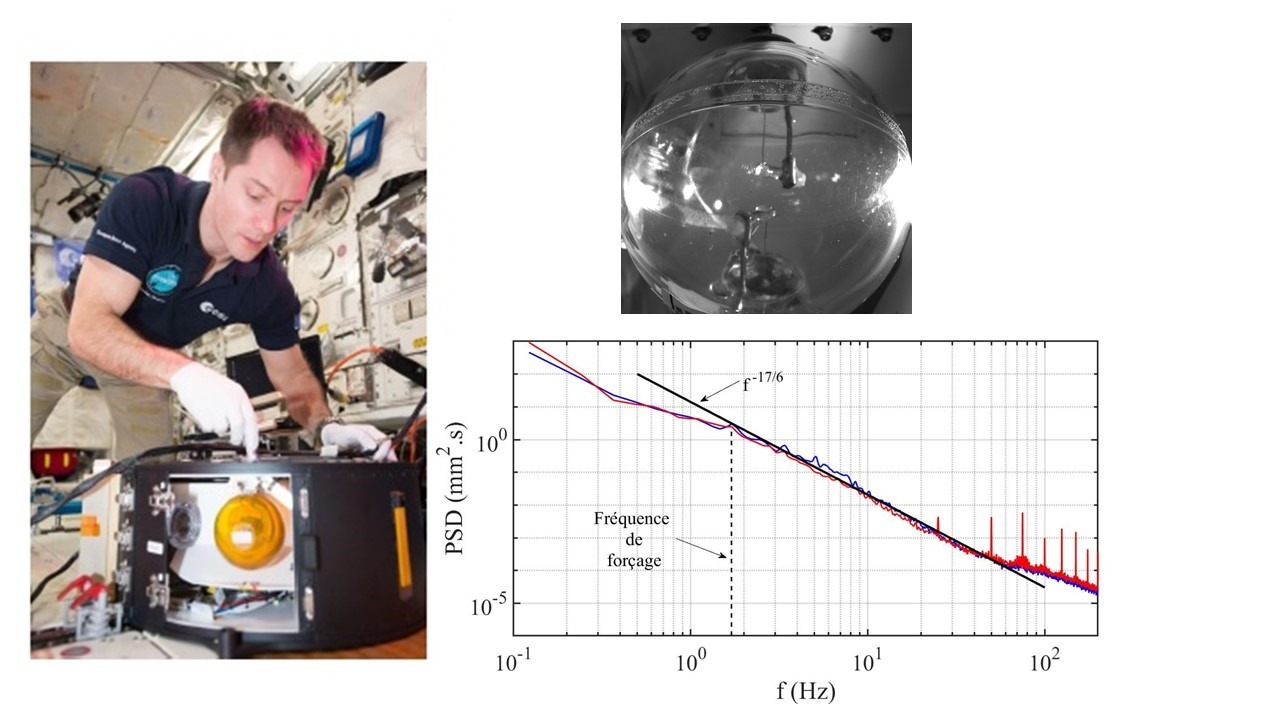
Caption: Left: Thomas Pesquet setting up the Fluidics experiment on the International Space Station. Credits CNES, CADMOS. Top right, a snapshot of the instrumented tank used to study capillary wave turbulence. The tank is a sphere 10 cm in diameter, 40% filled with water. Waves at the water/air interface are measured by capacitive sensors. Bottom right: power spectrum of these waves, for a forcing frequency of 1.7 Hz. A power-law spectrum over one and a half decades is obtained for both sensors, in agreement with the theoretical prediction.
Solitons and integrable turbulence
In collaboration with a non-linear optics team at the University of Lille and the Ecole Centrale de Nantes, we are interested in a statistical regime of non-linear waves, called integrable wave turbulence, corresponding to wave fields composed of numerous solitons. The first controlled synthesis of a dense gas of solitons from random gravity waves was achieved by measurements in a 150 m-long instrumented channel at the Ecole Centrale de Nantes. Using the same channel, the spontaneous emergence of so-called Peregrine solitons from a field of random waves was also observed, providing a possible explanation for the appearance of rogue waves.
Participant :
Eric Falcon
Theses of Guillaume Ricard and Annette Cazaubiel
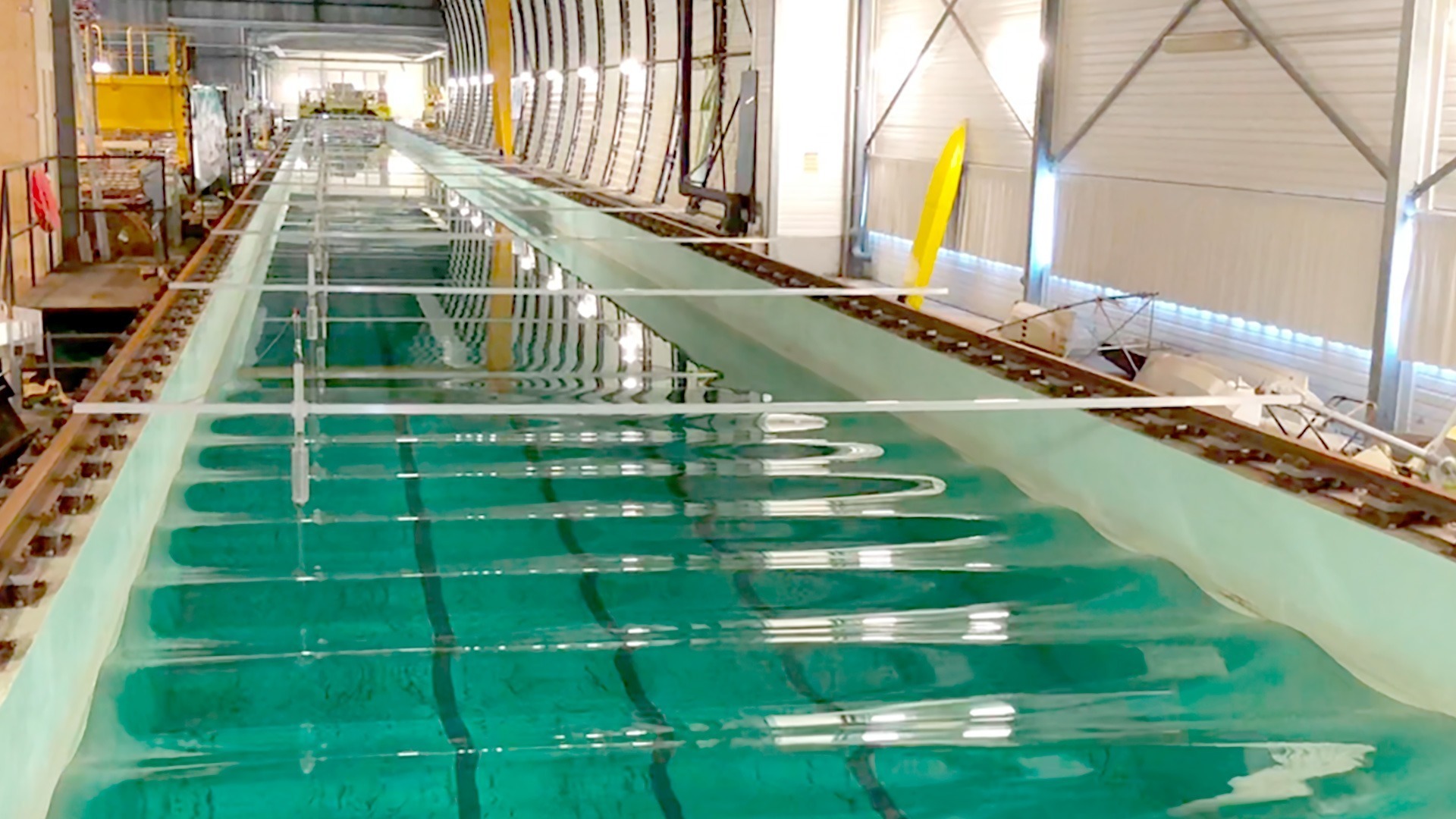
Caption: View of the 150 m channel at the École Centrale de Nantes, in which scélérates waves were characterized. Photo credit: Éric Falcon
Three-dimensional hydrodynamic turbulence
A new mechanism for forcing volume hydrodynamic turbulence has been developed at the MSC laboratory, using magnetized particles suspended in water and rotated by an oscillating external magnetic field. This method has enabled the first experimental observation of the large-scale statistical equilibrium regime in three-dimensional (3D) hydrodynamic turbulence, a regime predicted 70 years ago. These results pave the way for the use of equilibrium statistical mechanics concepts to describe the large scales of 3D turbulent flows, with potential applications to the large-scale dispersion of pollutants by turbulence.
Participants :
Eric Falcon, Jean-Baptiste Gorce, Jean-Claude Bacri
Thesis of Annette Cazaubiel
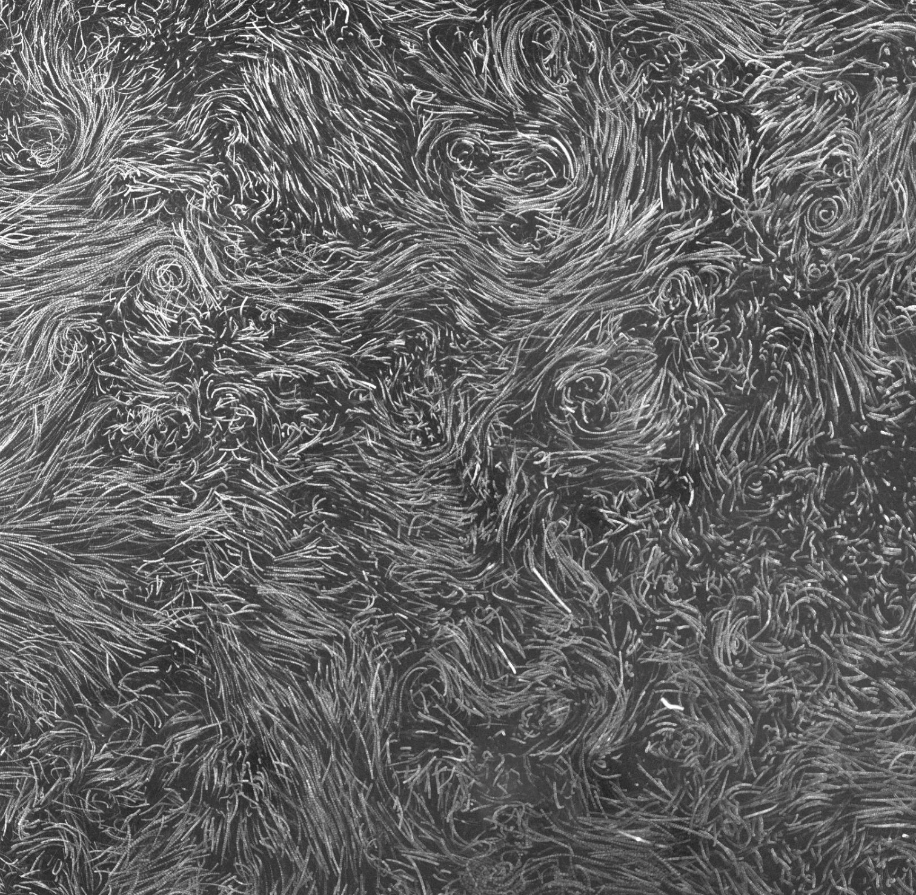
Caption: Image of 50 µm tracer trajectories in a 30 cm by 30 cm horizontal plane within three-dimensional turbulence.
Energy injection parameters: 55 magnetic particles; alternating magnetic field of frequency 20 Hz and amplitude 294 G.
©J.-B. Gorce et E. Falcon
Transport of a chain of particles on a periodic potential
We’re interested in a simple model of molecular transport in a highly confined environment, considering a chain of particles subjected to an external periodic potential. Even the simplest case, that of the dimer, already has surprisingly rich dynamics. This system has an internal mode of vibration and
a translational mode, and the underlying periodic potential induces a non-linear coupling between these modes. We have been able to show that this system belongs to the class of self-parametric systems, in which one of the vibrational modes parametrically excites the others (the other, in the case of the dimer).
Participants :
Christophe Coste, Michel Saint Jean
Thesis of Johann Maddi

Legend: From left to right: Vibrational amplitude of modes 10, 11 and 12 of a chain of 23 particles translating on a periodic potential.
Coupled oscillators
A harmonic oscillator with two degrees of freedom can easily be realized using two pendulums coupled by a spiral spring, all within the limit of small oscillations. The demonstration and study of the eigenmodes of such a “dipendulum” is an introductory example of coupled systems. But the analysis of such a device can be taken much further. For example, using the Glauber variables of each pendulum, we can construct three quantities (mx, myy, mz) whose classical commutation relations (Poisson’s brackets) are those of a kinetic moment. The dipendulum thus appears formally as a spin 1/2 immersed in a magnetic field (linked to the stiffness of the spring that couples the pendulums). A parametric modification of the length of one of the two pendulums simulates a rotating magnetic field. This system can be used to simulate (almost) all NMR experiments that can be performed with 1/2 spins. After transposing Larmor and Rabi precessions, we have developed a mechanical version of the famous “fast adiabatic transition”.
Participants :
Thierry Hocquet, Martin Devaud
